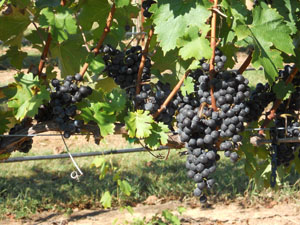Overview of the Oklahoma Grape and Wine Industry
Oklahoma has had a long-standing relationship with grape cultivation. Oklahoma once had vast vineyards of domesticated table and wine grapes in the late 1800s and early decades of the 20th Century. From 1919 to 1932, overall grape-related activity declined, although Oklahoma still produced more than 1800 tons of grapes on average – more than any state in the South Central U.S., aside from Arkansas, for the period of 1925 through 1928 (USDA, 1929).
A steady increase in grape production has occurred since the mid-1990s and recently, a resurgence of the grape growing and wine making industries in Oklahoma has led to an increase of vineyards, especially along the Route 66 corridor that runs through the state (Stafne, 2006). The winegrape industry in Oklahoma is primarily dependent upon V. vinifera cultivars, although some areas of the state have found hybrids and American cultivars more appropriate. As recently as 1997, approximately 170 acres of grapes were grown in the entire state of Oklahoma; that number grew to 375 acres in 2002 and 597 acres in 2007 (USDA, 2009). The number of licensed wineries has increased from 4 in 2001 to more than 60 in 2011 and continues to grow.
While much of the growing industry is supported by V. vinifera cultivars, opportunities remain for high-quality hybrids. Red grapes are preferred by growers with nearly 60% of the total acreage. Vitis vinifera dominates the species breakdown at nearly 80%. Hybrid grapes account for less than 15%, American species grapes approximately 7%, and muscadine grapes make up less than 1% of the total. The yields reported on a tons per acre basis range from 0.5 tons to 5 tons per acre, with an average of 2.4 tons per acre. The majority of grapes grown in Oklahoma are for use in wine, but grapes for fresh market, juice, and jelly are also being grown.
Of the V. vinifera (European) grapes grown in Oklahoma, Cabernet Sauvignon constitutes the most acres. Cabernet Sauvignon is considered to be a fairly cold tender European grape that is relatively easy to grow. It is also one of the most widely grown grapes in the world; hence it is not surprising that it is grown by many grape growers in Oklahoma. This cultivar also has very late budbreak in the spring, which is a beneficial trait for avoidance of spring frosts. Second behind Cabernet Sauvignon is Merlot, followed by Shiraz (Syrah). Both of these grapes make excellent red wines and are widely grown in grape growing areas throughout the world. However, neither of them is particularly cold hardy, thus they may be predisposed to injury from cold mid-winter temperatures as well as fluctuating fall, winter, and spring temperatures. Shiraz is also extremely vigorous and its vegetative growth is difficult to control. These two cultivars are probably grown in Oklahoma more from name recognition rather than appropriateness for the climate. Merlot and Shiraz are followed by Riesling. Riesling is one of the most cold-hardy European grapes. It may have some difficulties with the oppressive summer heat and high humidity in Oklahoma, but overall has been observed to have less winter injury when compared to other European grapes. Muscat Blanc and Chardonnay rank after Riesling. Chardonnay is somewhat cold hardy, but breaks bud early in the spring predisposing it to frost that can destroy succulent, green tissue and therefore result in crop reduction or loss. Zinfandel is also in the top 10 grapes grown in Oklahoma, but often has difficulty accumulating sugars in the fruit, and is too fruitful as well, leading to overcropping of vines. It is also highly susceptible to winter injury.
Presently, there appears to be no ceiling for grapes in Oklahoma. The industry is vibrant and public interest is high. The main obstacles for development of a sizable and sustainable industry are unfavorable liquor laws, lack of education, and, most prominently, environment (particularly cold and frost damage). The unpredictable continental climate of Oklahoma is one of the foremost obstacles for potential grape growers. It is essential that appropriate site selection be done prior to planting. Many locations in Oklahoma are unsuitable for most grapes, including hybrids and American grapes. European grapes are adapted to Mediterranean climates and do not tolerate cold winters or early spring frosts. There are areas where some European cultivars may succeed in Oklahoma because they do well on higher pH soils and are usually heat and drought tolerant. Southwestern Oklahoma counties provide the best environment for these types of grapes, but appropriate cultivar choice is essential. Many hybrid and American grapes are better suited for most areas of Oklahoma than European grapes. Growing grapes in Oklahoma is a risky endeavor and minimization of potential loss by consideration of cultivar and environmental interactions is paramount to ensure long-term success.
References:
Stafne, E.T. 2006. ‘Rubaiyat’ and Oklahoma’s winegrape legacy. Journal of American Pomological Society 60:159-163.
USDA. 1929. Statistics of fruits and vegetables. 1928 Yearbook of Agric. U.S. Dept. of Agric.
USDA. 2009. 2007 Census of Agriculture. U.S. Dept. of Agric.

